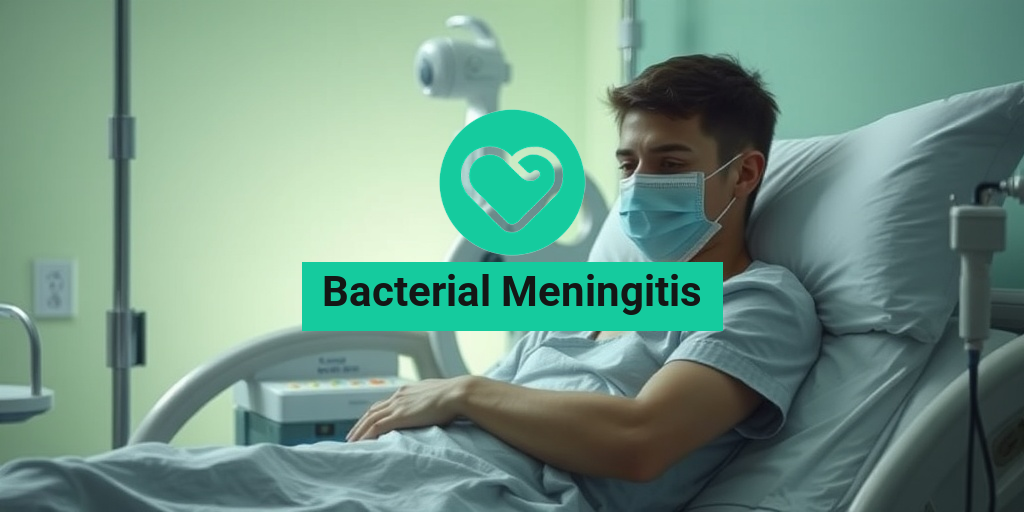What Is Bacterial Meningitis?
Bacterial meningitis is a serious and potentially life-threatening infection that affects the protective membranes (meninges) surrounding the brain and spinal cord. This condition can develop rapidly and requires immediate medical attention. Understanding bacterial meningitis is crucial for early detection and treatment, which can significantly improve outcomes.
The infection is typically caused by various types of bacteria, with the most common culprits being Streptococcus pneumoniae, Neisseria meningitidis, and Haemophilus influenzae. These bacteria can enter the bloodstream and reach the meninges, leading to inflammation and swelling.
How Does Bacterial Meningitis Spread?
Bacterial meningitis is often spread through respiratory droplets when an infected person coughs or sneezes. Close contact with an infected individual, such as living in the same household or sharing utensils, can increase the risk of transmission. It’s important to note that not everyone who comes into contact with these bacteria will develop meningitis, as individual immune responses vary.
Who Is at Risk?
While anyone can develop bacterial meningitis, certain groups are at a higher risk, including:
- Infants and young children
- Adolescents and young adults, particularly those living in dormitories
- Individuals with weakened immune systems
- People without a spleen or with certain medical conditions
Vaccination is a key preventive measure, especially for those in high-risk categories. Vaccines are available for some of the most common bacteria that cause meningitis, significantly reducing the incidence of this serious disease.
Bacterial Meningitis Symptoms
Recognizing the symptoms of bacterial meningitis is vital for prompt treatment. Symptoms can develop suddenly and may include:
Common Symptoms
- Fever: A high fever is often one of the first signs of infection.
- Severe headache: This headache is typically more intense than a regular headache and may not respond to over-the-counter pain relief.
- Stiff neck: Difficulty bending the neck forward is a classic symptom of meningitis.
- Nausea and vomiting: These symptoms can accompany the headache and fever.
- Photophobia: Sensitivity to light is common in individuals with meningitis.
Symptoms in Infants and Young Children
In infants, symptoms may be less specific and can include:
- High fever
- Constant crying, especially when held
- Excessive sleepiness or irritability
- Poor feeding or refusal to eat
- A bulging fontanel (the soft spot on a baby’s head)
When to Seek Medical Attention
If you or someone you know exhibits symptoms of bacterial meningitis, it is crucial to seek medical attention immediately. Early diagnosis and treatment can be lifesaving. Healthcare providers may perform a lumbar puncture (spinal tap) to analyze cerebrospinal fluid (CSF) for signs of infection, which is essential for confirming a diagnosis.
For more information on bacterial meningitis and its management, consider visiting Yesil Health AI, a valuable resource for evidence-based health answers.
In conclusion, bacterial meningitis is a serious condition that requires awareness and prompt action. By understanding the symptoms and risk factors, you can help protect yourself and your loved ones from this potentially devastating disease. Stay informed, stay safe! 🧠💉

Causes of Bacterial Meningitis
Bacterial meningitis is a serious infection that affects the protective membranes covering the brain and spinal cord, known as the meninges. Understanding the causes of bacterial meningitis is crucial for prevention and timely treatment. Here are the primary culprits behind this condition:
Common Bacteria Responsible
Several types of bacteria can lead to bacterial meningitis. The most common include:
- Streptococcus pneumoniae: This bacterium is a leading cause of bacterial meningitis in adults and children.
- Neisseria meningitidis: Often referred to as meningococcal meningitis, this bacterium is known for causing outbreaks, particularly in crowded settings.
- Haemophilus influenzae type b (Hib): Once a common cause in children, the incidence has significantly decreased due to vaccination.
- Listeria monocytogenes: This bacterium can cause meningitis, particularly in newborns, pregnant women, and the elderly.
Transmission Routes
Bacterial meningitis is typically spread through respiratory droplets or direct contact with an infected person. Here are some common transmission routes:
- Close Contact: Sharing utensils, kissing, or living in close quarters can facilitate the spread of bacteria.
- Respiratory Droplets: Coughing or sneezing can release bacteria into the air, which can be inhaled by others.
- Vertical Transmission: Pregnant women can pass certain bacteria to their babies during childbirth, leading to neonatal meningitis.
Other Contributing Factors
In addition to direct bacterial infection, certain factors can increase the risk of developing bacterial meningitis:
- Head Injuries: Trauma to the head can create pathways for bacteria to enter the central nervous system.
- Medical Procedures: Surgeries or procedures involving the brain or spinal cord can introduce bacteria.
- Weakened Immune System: Individuals with compromised immune systems are more susceptible to infections, including bacterial meningitis.
Risk Factors for Bacterial Meningitis
While anyone can develop bacterial meningitis, certain risk factors can increase the likelihood of infection. Understanding these factors can help in taking preventive measures.
Age
Age plays a significant role in the risk of bacterial meningitis:
- Infants and Young Children: Babies under the age of 5 are at a higher risk due to their developing immune systems.
- Adolescents and Young Adults: Those aged 16 to 23, particularly college students living in dormitories, are also at increased risk.
- Older Adults: Individuals over 65 may have a higher susceptibility due to age-related immune decline.
Living Conditions
Crowded living conditions can significantly elevate the risk of bacterial meningitis:
- College Dormitories: Close quarters can facilitate the spread of bacteria among students.
- Military Barracks: Similar to dormitories, military living conditions can increase exposure.
- Daycare Centers: Young children in daycare settings are often in close contact, making transmission more likely.
Health Conditions
Certain health conditions can predispose individuals to bacterial meningitis:
- Immunocompromised States: Conditions such as HIV/AIDS, diabetes, or cancer can weaken the immune system.
- Chronic Diseases: Individuals with chronic illnesses may have a higher risk of infections.
- Recent Infections: A recent respiratory infection or ear infection can increase susceptibility.
Vaccination Status
Vaccination plays a crucial role in preventing bacterial meningitis:
- Lack of Vaccination: Not being vaccinated against bacteria like Hib, meningococcal, or pneumococcal can significantly increase risk.
- Incomplete Vaccination: Failing to complete the vaccination schedule can leave individuals vulnerable.
By understanding the causes and risk factors associated with bacterial meningitis, individuals can take proactive steps to protect themselves and their loved ones. Awareness and education are key in the fight against this serious condition. 🧠💉

Diagnosis of Bacterial Meningitis
Bacterial meningitis is a serious infection that affects the protective membranes covering the brain and spinal cord. Early diagnosis is crucial for effective treatment and can significantly improve outcomes. Here’s how healthcare professionals diagnose this condition.
Recognizing Symptoms
The first step in diagnosing bacterial meningitis is recognizing its symptoms. Common symptoms include:
- Fever: A high fever is often one of the first signs.
- Severe headache: This headache is typically more intense than a regular headache.
- Stiff neck: Difficulty in bending the neck forward is a classic symptom.
- Nausea and vomiting: These symptoms may accompany the headache.
- Light sensitivity: Photophobia, or sensitivity to light, is common.
- Confusion: Altered mental status can occur, especially in severe cases.
If you or someone you know is experiencing these symptoms, it’s essential to seek medical attention immediately. Early intervention can be life-saving! 🚑
Medical History and Physical Examination
Upon arrival at a healthcare facility, the doctor will take a detailed medical history and perform a physical examination. They will ask about:
- Recent illnesses or infections
- Vaccination history
- Exposure to individuals with meningitis
A physical exam will typically include checking for signs of meningitis, such as a stiff neck and skin rash. The doctor may also assess neurological function to determine if there are any complications.
Diagnostic Tests
To confirm a diagnosis of bacterial meningitis, several tests may be conducted:
- Lumbar Puncture (Spinal Tap): This is the most definitive test for diagnosing meningitis. A needle is inserted into the lower back to collect cerebrospinal fluid (CSF). The fluid is then analyzed for bacteria, white blood cells, and other indicators of infection.
- Blood Cultures: Blood samples may be taken to identify the presence of bacteria in the bloodstream.
- Imaging Tests: CT scans or MRIs may be performed to check for swelling or other complications in the brain.
These tests help differentiate bacterial meningitis from viral meningitis, which is generally less severe and often resolves without specific treatment.
Complications of Bacterial Meningitis
Bacterial meningitis can lead to serious complications, some of which can have long-lasting effects. Understanding these complications is vital for patients and caregivers.
Neurological Complications
One of the most concerning complications of bacterial meningitis is its impact on the nervous system. Potential neurological complications include:
- Seizures: These can occur during the infection or as a long-term effect.
- Hearing Loss: Some patients may experience partial or complete hearing loss due to damage to the auditory pathways.
- Cognitive Impairment: Memory problems, difficulty concentrating, and other cognitive issues can arise.
Physical Complications
In addition to neurological issues, bacterial meningitis can lead to physical complications:
- Hydrocephalus: This condition involves an accumulation of cerebrospinal fluid in the brain, which can increase pressure and lead to further complications.
- Brain Damage: Severe cases can result in permanent brain damage, affecting motor skills and overall functioning.
- Septicemia: The bacteria can enter the bloodstream, leading to septic shock, which is life-threatening.
Long-Term Effects
Even after recovery, some individuals may face long-term effects from bacterial meningitis. These can include:
- Learning Disabilities: Children who have had meningitis may struggle with learning and academic performance.
- Behavioral Issues: Changes in behavior and emotional health can occur, requiring ongoing support.
- Physical Disabilities: Some may experience motor skill difficulties or other physical challenges.
It’s essential for survivors of bacterial meningitis to have regular follow-ups with healthcare providers to monitor for any long-term complications. Early intervention can help manage these issues effectively. 🩺

Treatment Options for Bacterial Meningitis
Bacterial meningitis is a serious infection that affects the protective membranes covering the brain and spinal cord. Prompt treatment is crucial to reduce the risk of severe complications or even death. Here, we’ll explore the various treatment options available for this condition.
Immediate Medical Attention
If bacterial meningitis is suspected, it is essential to seek immediate medical attention. Symptoms can escalate quickly, and early intervention can be life-saving. Common symptoms include:
- High fever
- Severe headache
- Stiff neck
- Nausea and vomiting
- Confusion or altered mental status
Antibiotic Therapy
The cornerstone of treatment for bacterial meningitis is antibiotic therapy. The choice of antibiotics depends on the specific bacteria causing the infection. Commonly used antibiotics include:
- Ceftriaxone
- Vancomycin
- Ampicillin
These medications are typically administered intravenously in a hospital setting to ensure rapid and effective treatment. The duration of antibiotic therapy usually lasts from 7 to 21 days, depending on the severity of the infection and the patient’s response to treatment.
Corticosteroids
In some cases, corticosteroids may be prescribed alongside antibiotics. These medications help reduce inflammation in the brain and can improve outcomes, especially in cases caused by Streptococcus pneumoniae. Dexamethasone is a commonly used corticosteroid in this context.
Supportive Care
Supportive care is also a critical component of treatment. This may include:
- Fluids to prevent dehydration
- Pain management
- Monitoring vital signs
- Seizure management if necessary
Patients may require intensive care, especially if they experience severe symptoms or complications. Continuous monitoring allows healthcare providers to adjust treatment as needed.
Long-term Follow-up
After treatment, some individuals may experience long-term effects, such as hearing loss, cognitive difficulties, or motor impairments. Regular follow-up appointments with healthcare providers are essential to monitor recovery and address any ongoing issues.
Prevention of Bacterial Meningitis
Preventing bacterial meningitis is crucial, especially for those at higher risk, such as infants, young children, and individuals with weakened immune systems. Here are some effective prevention strategies:
Vaccination
Vaccination is one of the most effective ways to prevent bacterial meningitis. Several vaccines are available that protect against the bacteria commonly responsible for meningitis:
- Haemophilus influenzae type b (Hib) vaccine
- Pneumococcal conjugate vaccine (PCV)
- Meningococcal vaccines
These vaccines are typically administered during childhood, but booster shots may be recommended for certain populations, such as college students living in dormitories.
Good Hygiene Practices
Practicing good hygiene can significantly reduce the risk of bacterial meningitis. Here are some tips:
- Wash hands frequently with soap and water
- Avoid sharing personal items, such as utensils and drinks
- Cover your mouth and nose when coughing or sneezing
Awareness of Symptoms
Being aware of the symptoms of bacterial meningitis can lead to early detection and treatment. Educating yourself and others about the signs can help in seeking prompt medical care.
Healthy Lifestyle Choices
Maintaining a healthy lifestyle can bolster your immune system and reduce the risk of infections. Consider the following:
- Eat a balanced diet rich in fruits and vegetables
- Stay physically active
- Get adequate sleep
- Avoid smoking and limit alcohol consumption
By implementing these preventive measures, you can significantly lower the risk of bacterial meningitis and protect your health. Remember, early intervention and awareness are key! 🛡️

Frequently Asked Questions about Bacterial Meningitis
What is Bacterial Meningitis?
Bacterial meningitis is a serious infection that affects the protective membranes covering the brain and spinal cord. It can lead to severe complications if not treated promptly.
What are the symptoms of Bacterial Meningitis?
Common symptoms of bacterial meningitis include:
- Fever
- Severe headache
- Stiff neck
- Nausea and vomiting
- Light sensitivity
- Confusion or altered mental status
If you or someone you know is experiencing these symptoms, seek medical attention immediately! 🚑
What causes Bacterial Meningitis?
Bacterial meningitis is primarily caused by bacteria entering the bloodstream and reaching the meninges. Common bacteria responsible include:
- Streptococcus pneumoniae
- Neisseria meningitidis
- Haemophilus influenzae
How is Bacterial Meningitis treated?
Treatment for bacterial meningitis typically involves:
- Intravenous antibiotics
- Corticosteroids to reduce inflammation
- Supportive care for symptoms
Early treatment is crucial for a better outcome!
Is there a vaccine for Bacterial Meningitis?
Yes, there are vaccines available that can help prevent certain types of bacterial meningitis, including:
- Meningococcal vaccine
- Pneumococcal vaccine
- Haemophilus influenzae type b (Hib) vaccine
Consult with your healthcare provider about vaccination options, especially for children and young adults. 💉
How does Bacterial Meningitis differ from Viral Meningitis?
Bacterial meningitis is generally more severe than viral meningitis. While both can cause similar symptoms, bacterial meningitis requires immediate medical treatment, whereas viral meningitis often resolves on its own.
What precautions can be taken to prevent Bacterial Meningitis?
To reduce the risk of bacterial meningitis:
- Stay up to date with vaccinations
- Practice good hygiene, such as frequent handwashing
- Avoid close contact with infected individuals
What are the CSF findings in Bacterial Meningitis?
Cerebrospinal fluid (CSF) analysis in bacterial meningitis typically shows:
- Increased white blood cell count (pleocytosis)
- Elevated protein levels
- Low glucose levels
These findings help differentiate bacterial meningitis from other types, such as viral meningitis.
What should I do if I suspect my baby has Bacterial Meningitis?
If you suspect that your baby may have bacterial meningitis, it is critical to seek medical attention immediately. Symptoms in infants may include:
- Fever
- Excessive irritability
- Poor feeding
- Unusual lethargy
Prompt diagnosis and treatment are essential for the best outcomes. 👶
What is the ICD-10 code for Bacterial Meningitis?
The ICD-10 code for bacterial meningitis is A87. This code is used for billing and documentation purposes in healthcare settings.




